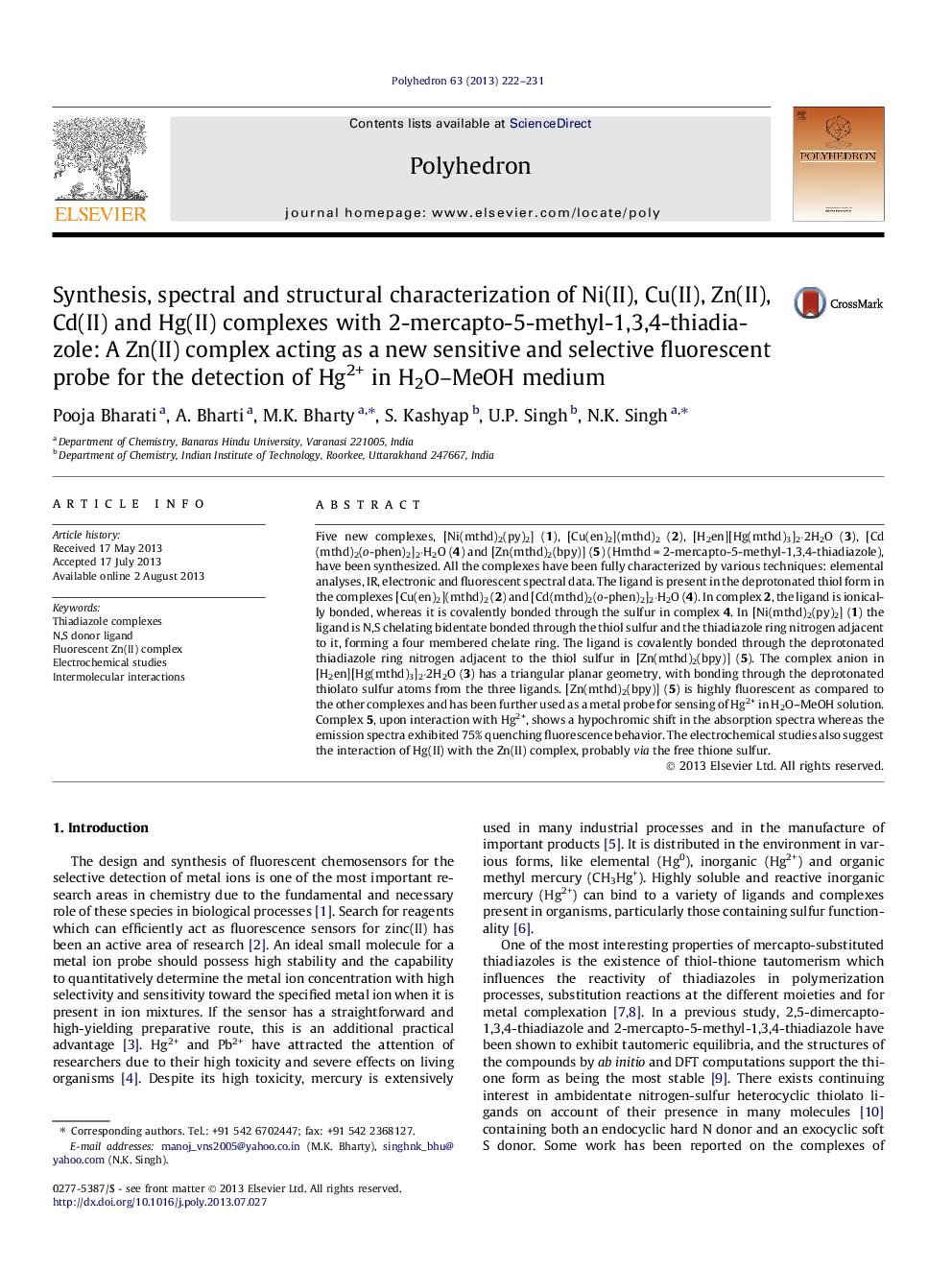| کد مقاله | کد نشریه | سال انتشار | مقاله انگلیسی | نسخه تمام متن |
|---|---|---|---|---|
| 1335578 | 1500276 | 2013 | 10 صفحه PDF | دانلود رایگان |

Five new complexes, [Ni(mthd)2(py)2] (1), [Cu(en)2](mthd)2 (2), [H2en][Hg(mthd)3]2·2H2O (3), [Cd(mthd)2(o-phen)2]2·H2O (4) and [Zn(mthd)2(bpy)] (5) (Hmthd = 2-mercapto-5-methyl-1,3,4-thiadiazole), have been synthesized. All the complexes have been fully characterized by various techniques: elemental analyses, IR, electronic and fluorescent spectral data. The ligand is present in the deprotonated thiol form in the complexes [Cu(en)2](mthd)2 (2) and [Cd(mthd)2(o-phen)2]2·H2O (4). In complex 2, the ligand is ionically bonded, whereas it is covalently bonded through the sulfur in complex 4. In [Ni(mthd)2(py)2] (1) the ligand is N,S chelating bidentate bonded through the thiol sulfur and the thiadiazole ring nitrogen adjacent to it, forming a four membered chelate ring. The ligand is covalently bonded through the deprotonated thiadiazole ring nitrogen adjacent to the thiol sulfur in [Zn(mthd)2(bpy)] (5). The complex anion in [H2en][Hg(mthd)3]2·2H2O (3) has a triangular planar geometry, with bonding through the deprotonated thiolato sulfur atoms from the three ligands. [Zn(mthd)2(bpy)] (5) is highly fluorescent as compared to the other complexes and has been further used as a metal probe for sensing of Hg2+ in H2O–MeOH solution. Complex 5, upon interaction with Hg2+, shows a hypochromic shift in the absorption spectra whereas the emission spectra exhibited 75% quenching fluorescence behavior. The electrochemical studies also suggest the interaction of Hg(II) with the Zn(II) complex, probably via the free thione sulfur.
The new complexes [Ni(mthd)2(py)2] (1), [Cu(en)2](mthd)2 (2), [H2en][Hg(mthd)3]2·2H2O (3), [Cd(mthd)2(o-phen)2]2·H2O (4) and [Zn(mthd)2(bpy)] (5) (Hmthd = 2-mercapto-5-methyl-1,3,4-thiadiazole) have been synthesized. The ligand is present in the deprotonated thiol form in the [Cu(en)2](mthd)2 and [Cd(mthd)2(o-phen)2]2·H2O complexes. In complex 2, the ligand is ionically bonded, whereas it is covalently bonded through sulfur in complex 4. In [Ni(mthd)2(py)2] (1) the ligand is N,S chelating bidentate bonded through the thiol sulfur and thiadiazole ring nitrogen atoms, forming a four membered chelate ring. The ligand is covalently bonded through the deprotonated thiadiazole ring nitrogen in [Zn(mthd)(bpy)2] (5). In the complex [H2en][Hg(mthd)3]2·2H2O (3) the complex anion has a triangular planar geometry, being bonded to the deprotonated thiolato sulfur atoms from the three ligands. Complex 5 upon interaction with Hg2+ illustrates a hypochromic shift in the absorption spectra, whereas the emission spectra exhibits 75% quenching fluorescence behavior. The electrochemical studies also suggest the interaction of Hg(II) with the Zn(II) complex, probably via free thione sulfur.Figure optionsDownload as PowerPoint slide
Journal: Polyhedron - Volume 63, 31 October 2013, Pages 222–231